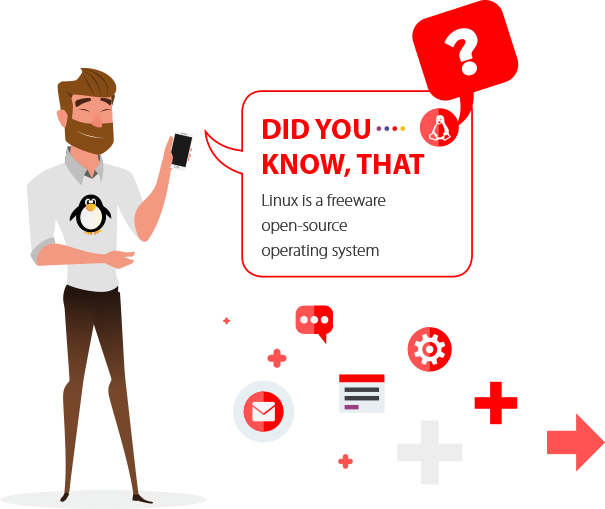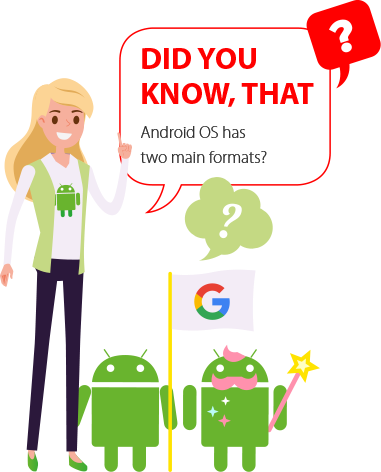Product request
You are looking for a solution:
Select an option, and we will develop the best offer
for you
Linux vs Android
Traditionally, manufacturers of IPTV/OTT set-top boxes have used developments based on the Linux kernel and the operating system family of the same name to create a unique user experience.
In this infographics, we have selected for you the main advantages and disadvantages of customary solutions based on the Linux OS and compared them with Android TV, one of the most promising Android solutions for this market.

This is a set of development tools, which then form the basis of the device operating system and the user environment.
Every day, viewers see on their screens the solution created especially for them.
The pros of Linux-based devices:
Product uniqueness
Viewer gets a device with the interface and other components created specifically to suit their needs. It’s also a benefit for the operator because the device can be developed for specific business requests: from the simple and inexpensive to a set-top box with a broad functionality, including integration with a specific CAS/DRM.


Adaptability of changes
The manufacturer constantly receives feedback from operators and end users. Thus, they is always refining the OS as new technologies appear on the market. The release of new firmware upgrades allows improvement of the device even after launching mass production, thereby prolonging its life cycle.
Easy controls
A simplified mechanism for administering set-top boxes and maximum control over the user interface are the most important criteria by which the operator chooses an STB. It is also necessary to proceed from compatibility with the middleware, which allows such administration ..



Resource costs
Since almost every chipset manufacturer has its own set of development tools, set-top box manufacturers have to spend a lot of resources creating and maintaining a line of devices with different processors. This is why the launch of the final product on the market usually takes a long time.

Functionality
As new technologies develop, support for a number of functions largely depends on the processor. A choice of device components plays a key role in its capabilities. Basic IPTV/OTT set-top boxes , released five or six years ago, still operate with IPTV and perform their task perfectly well, but no longer support new graphics or video-decoding technologies.

Applications
The app trend is rapidly encompassing more and more devices, including set-top boxes. Users cite the lack of support of big platforms with applications as a disadvantage of Linux-based devices, while manufacturers and operators develop their own solutions or attract third-party companies to meet these challenges.

Android TV
Android TV Used by Google-certified companies. Its main advantage is that only Android gives access to the official Google Play Market and multiple applications of the ecosystem.
1
Android Open Source Project AOSP —
is a free version that enables device manufacturers to change everything that they consider important. They can control every UI element and manage the installation of thirdparty applications.
Interface
Android provides developers with ample opportunities to visualise graphical UI elements along with fast response to user commands. Users note the high quality and user-friendliness of the Android-based device interface. It is one of the decisive criteria in driving them to buy.


Applications and updates
Developers and operators can create their own applications and publish them on the Google Play Store platform. For its part, Google regularly releases OS updates and adds new features.
Interoperability and compatibility
The ecosystem of Android-based applications, services, and devices is the pride of the company, the OS itself interacts consistently with all of them.


A wide choice of predefined functionality
Android allows the easy launch of numerous services supported at the hardware level. For example, 3D graphics and Picture-In-Picture (PiP), as well as many others.
Disadvantages of Android OS
Control over updates
Device manufacturers and operators are forced to accept the fact that updates, and the OS as a whole, are under the control of its developers.
Requirements compliance
For many IPTV/OTT operators, control over project management plays a crucial role. If they use Android TV, they must constantly meet its compatibility requirements and quickly respond to any changes in them.
Device compatibility
Since the technical requirements for the performance of Android TV devices are quite high, this affects the cost of the device for the user.
Today, the lines of almost all manufacturers consist of devices based on both Linux and Android. Both platforms are actively used in the IPTV/OTT market. The choice of a platform is a fundamentally important decision for every service provider or product manufacturer. We recommend paying attention not only to personal preferences but also to trends among end users.
Recommended

How to Properly Organize Backup Servers for IPTV Streams
The IPTV and OTT market is growing rapidly, with the quality of broadcasts continuing to improve, the number of channels increasing, and the functionality of set-top boxes and applications expanding.

The Evolution of Codecs: From H.264 to AV1 and VVC — What Should Operators Choose?
Over the past decade, the video market has undergone a rapid shift from linear TV to flexible IPTV/OTT services, where image quality and delivery efficiency play a crucial role.

Network Monitoring in IPTV: Key Metrics for Daily Quality Control
It's no surprise that the development of IPTV and OTT services has increased the demand for network stability and predictable content delivery quality.










